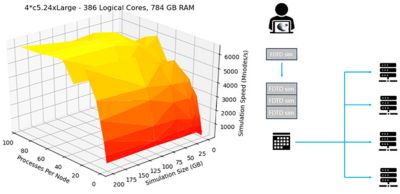-
-
학생용 무료 소프트웨어에 액세스하기
차세대 엔지니어에게 힘을 실어주는 Ansys
학생들은 세계적 수준의 시뮬레이션 소프트웨어를 무료로 이용할 수 있습니다.
-
지금 바로 Ansys에 연결하십시오!
미래를 설계하기
시뮬레이션이 다음 혁신을 어떻게 지원할 수 있는지 알아보려면 Ansys와 연결하십시오.
국가
무료 트라이얼
제품 및 서비스
학습하기
회사 정보
Back
제품 및 서비스
ANSYS BLOG
July 27, 2020
Simulate Light Faster with Ansys Lumerical’s HPC Workflows
The next episode of Ansys’ photonics webinar series presents the latest workflows for high-performance computing (HPC) with Ansys Lumerical tools. HPC allows you to meet aggressive deadlines on time and on budget, and provides you with the ability to verify designs too large to practically simulate other ways.
The adoption of photonics technology is increasing every year due in part to demanding applications in high-growth industries such as datacom, automotive lidar, quantum computing, sensing, augmented reality/virtual reality (AR/VR) and display technology. Engineers in these application spaces face larger, more complex design problems with increased pressures to get to market first.
Support for Photonic Inverse Design
Compute-intensive optimization techniques such as photonic inverse design (PID) are used by engineers to stretch their ideas to the performance limit. Design improvements that would otherwise be conceptually impossible can be achieved with PID, often requiring access to large-scale computing clusters to meet ambitious deadlines. Ansys Lumerical supports both PID and cloud deployment, supporting your next-generation photonics designs.
Whether on-premise or in the cloud, using HPC helps you meet aggressive deadlines. HPC workflows distribute the simulation effort across multiple nodes, allowing a job that would take 10 hours on a single computer to run in one hour on 10 computers for the same cost.
Cloud platforms enable on-demand access to massive computing resources during peak times of the development cycle. They provide secure, flexible, elastic computing with leading-edge hardware, minimal upfront cost and no maintenance.
Simulate Light Faster with Ansys Lumerical
Ansys supports workflows for its Lumerical photonic simulation tools that allow you to quickly and seamlessly migrate your simulation workflows to in-house and cloud platforms.
Key HPC Features available for Lumerical products include:
- Support for accelerating very large simulations by distributing them across multiple nodes
- Support for accelerating parameter sweeps by concurrently running them on multiple cores
- Job check pointing to reduce computing costs, enabling users to recover from hardware failures or to access market pricing from cloud providers
- Optimized Python API data transfer and meshing efficiency to maximize HPC performance
- Support for third-party cluster management and job scheduler tools
Ansys Lumerical has continued to improve HPC simulation performance for its meshing and Python API (left) and now supports third-party cluster and job scheduler tools (right).
To date, leading photonics designers have used Ansys's HPC solution for Lumerical products to achieve results not possible otherwise. In some cases, HPC has been coupled with photonics inverse design to generate non-intuitive designs that perform better and have a smaller area footprint than designs generated by hand. In other cases, HPC has been used for verification on very large designs that would normally be difficult to simulate because of their memory requirements and unreasonably long run times.

